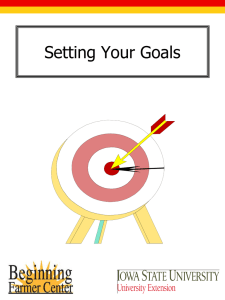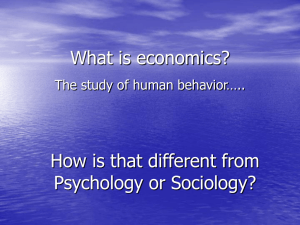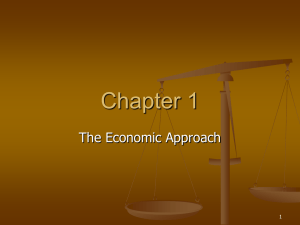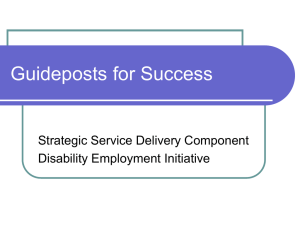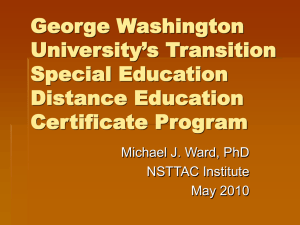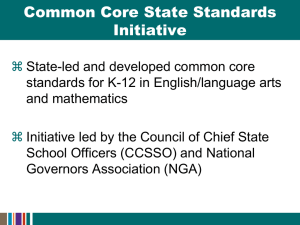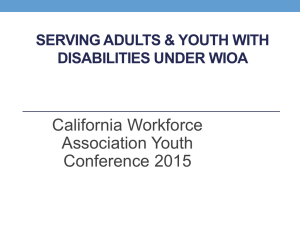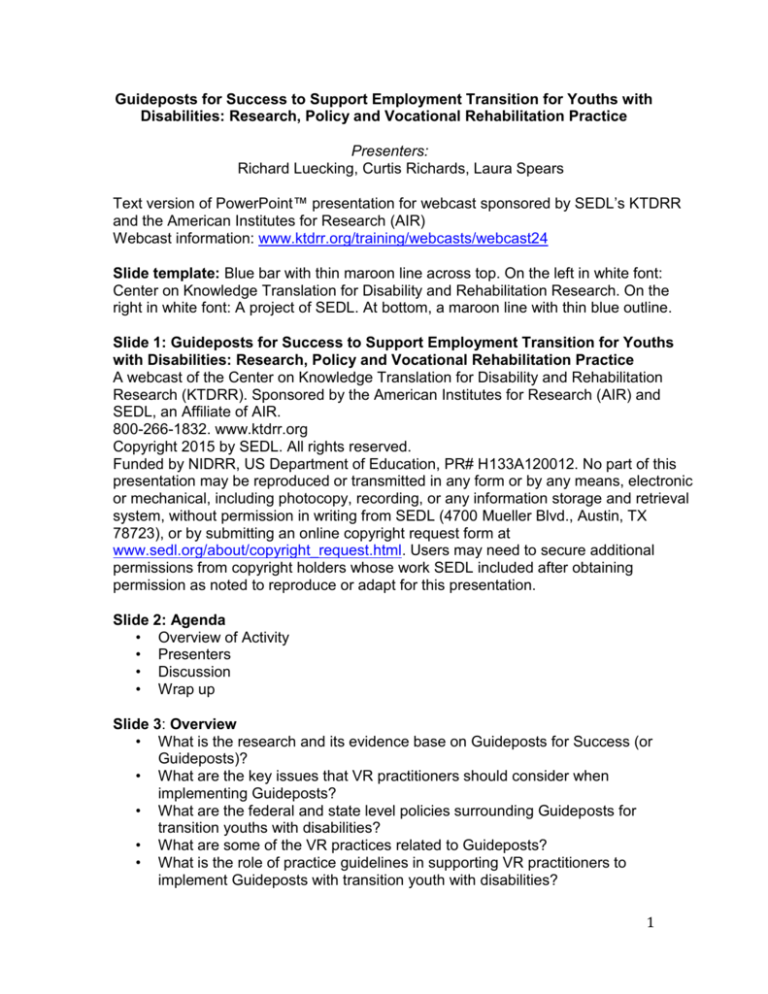
Guideposts for Success to Support Employment Transition for Youths with
Disabilities: Research, Policy and Vocational Rehabilitation Practice
Presenters:
Richard Luecking, Curtis Richards, Laura Spears
Text version of PowerPoint™ presentation for webcast sponsored by SEDL’s KTDRR
and the American Institutes for Research (AIR)
Webcast information: www.ktdrr.org/training/webcasts/webcast24
Slide template: Blue bar with thin maroon line across top. On the left in white font:
Center on Knowledge Translation for Disability and Rehabilitation Research. On the
right in white font: A project of SEDL. At bottom, a maroon line with thin blue outline.
Slide 1: Guideposts for Success to Support Employment Transition for Youths
with Disabilities: Research, Policy and Vocational Rehabilitation Practice
A webcast of the Center on Knowledge Translation for Disability and Rehabilitation
Research (KTDRR). Sponsored by the American Institutes for Research (AIR) and
SEDL, an Affiliate of AIR.
800-266-1832. www.ktdrr.org
Copyright 2015 by SEDL. All rights reserved.
Funded by NIDRR, US Department of Education, PR# H133A120012. No part of this
presentation may be reproduced or transmitted in any form or by any means, electronic
or mechanical, including photocopy, recording, or any information storage and retrieval
system, without permission in writing from SEDL (4700 Mueller Blvd., Austin, TX
78723), or by submitting an online copyright request form at
www.sedl.org/about/copyright_request.html. Users may need to secure additional
permissions from copyright holders whose work SEDL included after obtaining
permission as noted to reproduce or adapt for this presentation.
Slide 2: Agenda
• Overview of Activity
• Presenters
• Discussion
• Wrap up
Slide 3: Overview
• What is the research and its evidence base on Guideposts for Success (or
Guideposts)?
• What are the key issues that VR practitioners should consider when
implementing Guideposts?
• What are the federal and state level policies surrounding Guideposts for
transition youths with disabilities?
• What are some of the VR practices related to Guideposts?
• What is the role of practice guidelines in supporting VR practitioners to
implement Guideposts with transition youth with disabilities?
1
Slide 4: Presenters
• Richard Luecking, Ed.D, President of TransCen, Inc., Co-Principal Investigator
for the National Center on Transition to Employment for Youth with Disabilities
• Curtis Richards, Director, National Collaborative on Workforce & Disability for
Youth, Institute for Educational Leadership
• Laura Spears, BA, Transition Services Coordinator, South Carolina Vocational
Rehabilitation Department
Slide 5: Guideposts for Success (NCWD/Y, 2005)
• School-based preparatory experiences
• Career preparation and work-based learning experiences
• Youth development and leadership
• Connecting activities
• Family involvement and supports
Slide 6: Academic Preparation & Work: Phillip becoming a graphic designer
Picture of Phillip sitting at a desk with a laptop.
Slide 7: Youth Empowerment: Kyndal at Sinai Hospital
• Job in telecommunications department as the result of leading her IEP
Picture of Kyndal seated in a wheelchair surrounded by 5 people
Slide 8: Service Connections: Camille at Department of Corrections
Picture of Camille standing behind a desk accompanied by a police officer
Slide 9: Family Supports: Ramon at Dr. Morgenstern
Picture of Ramon looking at a piece of paper next to shelves full of files
Slide 10: Work!: Tamika at Department of Agriculture
Picture of Tamika going through a rolodex
Slide 11: Work!: Kirsten at Consumer Product Safety Commission
Picture of Kirsten sitting at a desk
Photographs on slides 6-11 used with permission from TransCen, Inc.
Slide 12: Transitioning Youth: A Common Definition?
Definitions in use:
• Ages 16 – 21 (IDEA)
• Ages 16 – 24 (WIA)
• Ages 14 – 24 (YTD Demonstration)
A useful way for VR to consider transitioning youth:
• Begin service 2 years prior to projected school exit
• Continue service post-school until case closure
2
Slide 13: Research and the Guideposts framework
• National Youth Transition Demonstration (Fraker, et. al, in press)
– Work and earnings of youth on SSI increase under certain conditions
• Maryland Seamless Transition Collaborative (Luecking & Luecking, 2013)
– Youth exit school with employment and/or post-secondary education
enrollment in place
Slide 14: Guideposts and VR Practice
• Early case initiation (two years prior to projected school exit) = higher rates of
successful case closures
• Collaboration with education and other community partners = higher rates of
successful case closures
• WORK and JOB EXPERIENCE prior to school exit = higher likelihood of adult
employment
• Not just any job: Youth empowerment, family supports = better job matches and
longer job tenure
Slide 15: Key policies for employment of transitioning youths with disabilities
• National Policies Grounded in Federal Law & Regulations
• Individuals with Disabilities Education Act (IDEA)
• Age = Not later than 16
• Planning for postsecondary education, employment, & community living
• IEPs, Due Process, Student Involvement
• Content of Transition Services
• Outcome Indicators = 13 & 14
Slide 16: More Federal Policy
• Workforce Innovation & Opportunity Act (WIOA)
• Title I Youth Services
• Emphasis on career development and pathways
• Emphasis on out-of-school youth (75%)
• Work-based learning requirements (20%)
• Improved Outcome Measures
• Title I Disability Provisions
• Nondiscrimination, accessibility, & advisory board
Slide 17: More Federal Policy (continued)
• WIOA Title IV: Vocational Rehabilitation Act
• Required to work with schools
• VR Can Pay for Transition Services
• Emphasis on Competitive, Integrated Employment
• New Emphasis
• 15% of Transition, 50% of Supported Employment
• Increased emphasis on exploring and practicing work
• Pre-employment transition services
• Discourages subminimum wage placements
3
Slide 18: State & Local Policy
• Implementing State Legislation & Regulations
• IDEA age alignment (14 vs 16)
• ILPs & IEPs
• State Agency Leadership Initiatives
• Sparked by Federal Grants (e.g. YTDP, PROMISE)
• Interagency Collaboration
• Resource driven
• Culture & Myth
Slide 19: Differences and Similarities in Policies Across States
• Lot of similarities aligned with federal policy
• Some big differences
• IDEA age alignment
• When VR is in schools
• VR supporting postsecondary education
• Cooperative Agreements
• Work-based learning requirements
• Sheltered employment placements
Slide 20: Policy Implication of Research on Guideposts for Success
• Guideposts built on 30 years of research & demonstration projects
• Only a little research based on the Guideposts
• Guideposts are helping influence policy & practice
• Guideposts are 10 years old
• Lot of new research in the last 5 years
• In midst of updating as we speak
Slide 21: Strategies for Stronger Impacts on Federal and State Policy
• Education of state and local agency and program staff
• In service & pre service training and professional development
• Creation of more implementation tools
• More research based on utilization
Slide 22: Your Advice for VR Practitioners when Implementing Policies Related to
Guidepost for Success or Similar Models
• Guideposts are merely a framework for looking at the whole needs of youth
• Use as a checklist of sorts
• Use to identify resources & partners
• Look for professional development opportunities
• Learn from peers
• Use existing tools, create your own, ask for more
Slide 23: The Guideposts for Success & SCVRD Transition Services
4
South Carolina VR Department (SCVRD) uses the Guideposts for Success (the
Guideposts) as a framework for defining, developing, and tracking its youth transition
services and programs throughout the state.
State Perspective on Using the Guideposts for Success-South Carolina
http://www.ncwd-youth.info/innovative-strategies/state-perspectives/south-carolina
Slide 24: How We Started
• SCVRD implemented it’s first High School High Tech (HS/HT) program in 2005.
– Looked at how Florida implemented HS/HT
– Florida developed an activity guide based on the Guideposts:
http://www.abletrust.org/hsht/resources/_doc/Activities-Toolkit-2012-2013Introduction.doc
Image of logo in bottom right corner: High School (two stylized people on left) – High
Tech (stylized computer on right). Below image: South Carolina
Slide 25: Taking it a step further
• In 2007 SCVRD was awarded a 5-year transition demonstration grant to fund a
Youth Employment Services program in four sites.
– Incorporated Guideposts-aligned activities
– Developed a Student Profile to collect personal, social, work experience
history to assess student’s strengths and interests.
Bottom right corner: Image of a clipboard with check boxes and a pencil with the first
box checked off.
Slide 26: Incorporating Guideposts into all Transition Services
• Exposing students to various career options and role models through career
exploration activities (e.g. Disability Mentoring Day job shadowing, mentoring,
and service learning);
• Helping students develop and practice soft skills through group activities with
supportive peers;
• Engaging students in individualized work experiences while they are still in high
school; and
• Promoting self advocacy and leadership skills development opportunities through
participation in the state’s Youth Leadership Forum.
Slide 27: Aligning VR Services with the Guideposts
6 column Spreadsheet of Transition from School to Work Service Matrix
Column 1: Guideposts for Success- SCVRD Provided/ Arranged Services
Column 2: Preparatory Experiences- ACE Assessment, Career Exploration, Workforce
Trends, Field Trips to Post-Secondary Training, Job Seeking and Survival skills
instruction, Counseling and Guidance, Guest Speakers
Column 3: Work Experiences- Job readiness training, on-the-job tryout, internships,
participation in work experiences provided through other entities, job shadowing, site
visits to industry, part-time jobs
5
Column 4: Personal development and leadership- youth leadership forum (YLF); Junior
Achievement; participation in service learning; participation in school sponsored extracurricular activities; exposure to role models; mentoring; youth leadership activities i.e.
self advocacy, building confidence, and communication skills; disability history, culture,
and policy; goal setting
Column 5: Connecting services- diagnosis and treatment; rehabilitation technology;
post-secondary training; information and referral to other community service providers;
personal assistance services; transportation; benefits planning; tutoring; maintenance;
interpreter services; occupational licenses, tools, equipment, etc. JOB PLACEMENT,
supported employment.
Column 6: Family Involvement- consultation with parent(s)/Guardians(s) regarding
assessments, services, progress and outcomes; communicating transition planning
Slide 28: Current Practices
• All new transition counselors attend Transition 101and are introduced to the
Guideposts
• “Guidepost Activity” is a category used when documenting in Case Notes (cover
of Guideposts for Success pictured)
• Each Guidepost will be included on the student’s IPE
Image of Guideposts for Success cover.
Slide 29: Practice Guidelines Discussion
Slide 30: How can practice guidelines help VR practitioners to implement
Guideposts to support employment of transition youth?
• Guideposts serves as a framework for optimum transition practice because they
are research-based
• For VR practitioners this points to those interventions that are most likely to lead
to successful post-school employment for youth
Slide 31: How can practice guidelines help VR practitioners to implement
Guideposts to support employment of transition youth? (cont.)
• Guideposts ARE “standards of practice” or practice guidelines
• NCWD/Youth has a number of “guides” applying the Guideposts
• LD, MHN, JJ, FC, SD, Families
• YSP/KSA Standards & Study guide
• Resource mapping tool
Slide 32: How can practice guidelines help VR practitioners to implement
Guideposts to support employment of transition youth? (cont.)
• Provide structure in ensuring transition youth receive services that will provide
the most successful outcomes.
• Broaden the scope of possibilities for students.
Slide 33: What type of information should the guide include?
• Guideposts components suggest these VR practices
6
– Early case initiation (two years prior to projected school exit) = higher
rates of successful case closures
– Collaboration with education and other community partners = higher rates
of successful case closures
– WORK and JOB EXPERIENCE prior to school exit = higher likelihood of
adult employment
– Not just any job: Youth empowerment, family supports = better job
matches and longer job tenure
Slide 34: What type of information should the guide include? (cont.)
• NCWD/Youth approach
• Guides should start with common definitions/populations
• Explanation of the Guideposts with all elements
• Application of each category with background information, examples, tools and
resources
Slide 35: What type of information should the guide include? (cont.)
• The guide should be simple and easy to follow
• A foundation to include the evidence that supports this is an effective
model
• An explanation of what the Guideposts are
• Examples of how the Guideposts are utilized
• Outcome measures based on research of the Guideposts
Slide 36: Who should be involved in developing the practice guidelines?
• People knowledgeable about the Guideposts, transition to employment, and VR
including:
– Researchers
– VR counselors
– State VR agency staff
– Transition coordinators
– Employers
– Transitioning youth with disabilities and their family members
Slide 37: Who should be involved in developing the practice guidelines? (cont.)
• When developing the Guideposts, more than 50 national and state
organizations/leaders were involved representing a broad stakeholder base
• Convened separate “practice networks” for each of the subpopulation Guideposts
• Always need to cast a wide net to capture multiple stakeholder input/advice
Slide 38: Who should be involved in developing the practice guidelines? (cont.)
• The developers of the Guideposts
• Professionals who can identify practices they use based on the Guideposts
• Any organization that serves transition youths to facilitate employment
• An employer(s) who is able to identify and understand the Guideposts
7
Slide 39: Wrapping Up! Thank you for participating!
• We invite you to:
• Provide your input on today’s webcast
• Share your thoughts on future webcasts topics
• Participate in the Community of Practice to continue the dialogue
• PLEASE CONTACT US: ktdrr@sedl.org
Please fill out the brief evaluation form:
http://www.surveygizmo.com/s3/1844943/Transition-Eval
Slide 40: Disclaimer
This presentation was developed for grant number H133A120012 from the National
Institute on Disability and Rehabilitation Research (NIDRR), Office of Special Education
and Rehabilitative Services (OSERS), U.S. Department of Education. However, the
contents do not necessarily represent the policy of the Department of Education, and
you should not assume endorsement by the federal government.
8

